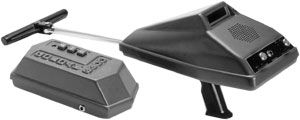Megger 656621 Cable Testers

Follow us for the latest equipment specials.
New Megger 656621

Sell Equipment Repairs Add to cart E-mail this page Alert me when this goes on sale
Megger 656621 Details
Megger 656621
AccuTrace Cable Route Trace
The AccuTrace Cable Route Tracer consists of a transmitter, which energizes the
line with a traceable signal, and a portable receiver, which detects the signal.
The transmitter can energize the line either by magnetic induction from a
built-in antenna or by direct conductive connection to the metallic line.
Energizing the line conductively provides increased tracing distance and minimizes signal coupling to other lines. Inductive coupling, which does not require a mechanical connection to the line, permits a buried line to be traced without uncovering or de-energizing it.
The transmitter provides a simple LO/HI pushbutton to adjust the transmitted signal's strength, and a PULSE button for battery conservation and easy identification of the signal.
The receiver can be used to trace lines using either peaks (detection of the maximum signal) or nulls (detection of the minimum, or zero, signal).
The antenna is swivel-mounted for operation in vertical, horizontal or 45 mode used to calculate depth. The receiver provides audible and visual indication of detected signal strength. Simple controls adjust sensitivity and amplification, and a jack provides for audio output to an optional headset.
Standard AA batteries provide up to30 hours of continuous operation. When the receiver is not in use, the telescoping handle retracts for convenient, compact storage
Features:- Easy to use and simple to operate, this cable route tracer can be used successfully the first day in the field.
- Conductive coupling lets the operator discriminate between multiple utility cables in a common trench and trace the line of interest. Conductive tracing also increases tracing distance.
- Inductive coupling lets the signal be transmitted without a direct metal-to-metal connection. The operator can trace an energized cable using a distinctive transmitted signal. Also, cables that do not have exposed terminations can be traced with ease.
- Both peak- and null-tracing mode methods can be used during a single trace to ensure accuracy and speed. Null tracing is very fast and can be used to identify sharp direction changes. Peak tracing can be used to find the cable at the start of the trace and to identify cable location when conditions make null tracing ineffective.
Each Unit Includes:
- Receiver
- Transmitter
- Direct Connection Cable
- Ground Rod
- Suitcase-Style Carrying Case
- Standard "AA" Batteries
- Operation Manual




